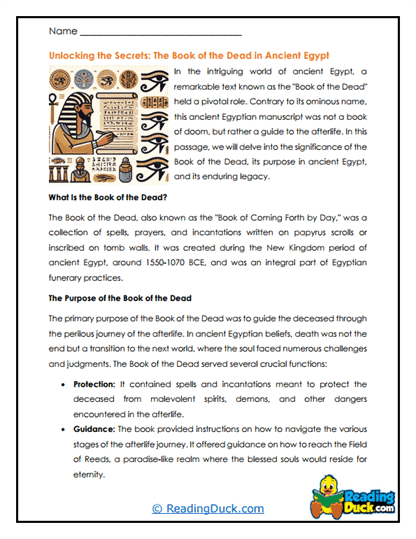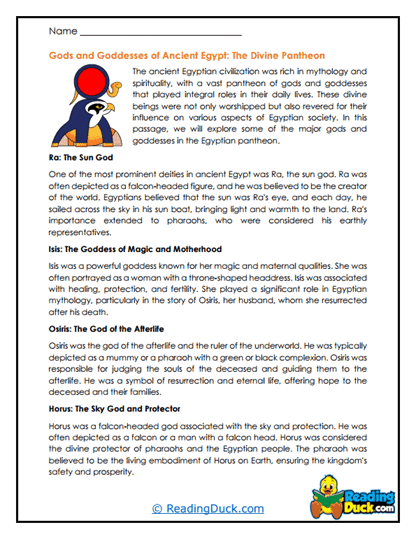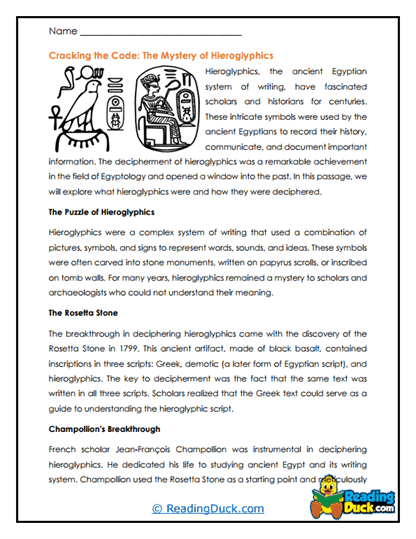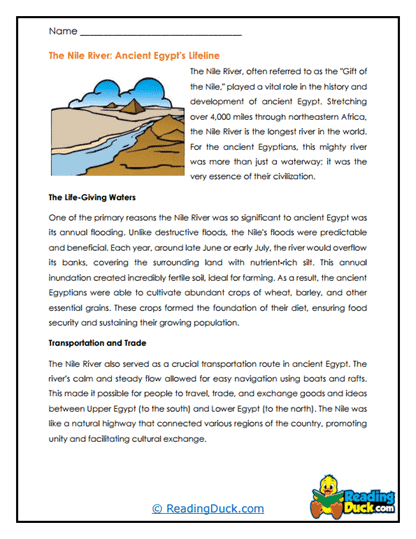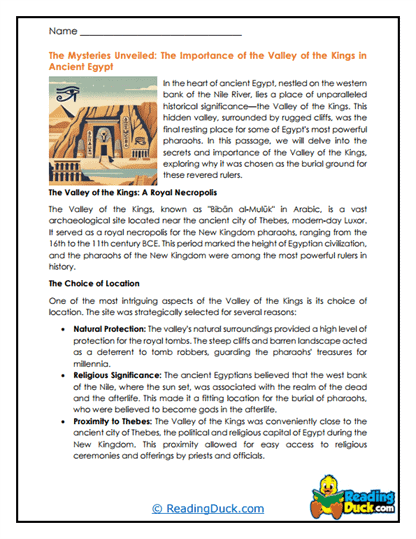Ancient Egypt Worksheets
About Our Ancient Egypt Worksheets
Our Ancient Egypt worksheets offer a deep dive into one of the most fascinating civilizations in world history. Through these resources, students will explore the grandeur of Ancient Egypt, from its towering pyramids to the intricate hieroglyphs that tell the stories of pharaohs and gods. Each worksheet set in this collection provides a comprehensive look at different aspects of Ancient Egyptian culture, society, and history.
Each topic in this collection contains several worksheet sets, structured to engage students and enhance their understanding through a variety of question formats:
- Multiple Choice Questions: These questions help assess students' retention of key facts about Ancient Egypt, such as significant pharaohs, gods, and historical events.
- Short Answer Questions: Students are encouraged to express their understanding of more complex ideas, such as the significance of the Nile River or the role of religion in Ancient Egyptian society.
- Open-Ended Questions: These questions invite students to offer their own interpretations or opinions about what they’ve learned, allowing for personal connection and deeper reflection on the material.
Each worksheet is accompanied by an answer key, which makes it easy for teachers and parents to evaluate students' progress. The worksheets are available in PDF format, making them convenient for electronic viewing, downloading, and printing.
Exploring the World of Ancient Egypt: A Journey Through Time
Ancient Egypt, with its rich history and culture, is a cornerstone of world history that captures the imagination of students. When introducing this topic, teachers can focus on several key aspects:
- Geography and the Nile River:
- The Lifeblood of Egypt: The Nile River was central to the development of Ancient Egyptian civilization. Its predictable flooding cycles provided fertile soil for agriculture, which was the foundation of Egypt’s economy and society.
- Strategic Location: Egypt's location, bordered by deserts, provided natural protection against invasions, allowing the civilization to flourish for thousands of years. The Nile also served as a major trade route, facilitating cultural and economic exchanges.
- Pharaohs and Dynasties:
- God-Kings: Pharaohs were not just political rulers; they were considered gods on earth. Understanding the concept of divine kingship is crucial for grasping how the pharaohs were able to maintain their power and influence.
- Major Dynasties: The study of key dynasties, such as the Old Kingdom (known for the construction of the pyramids), the Middle Kingdom (a period of cultural renaissance), and the New Kingdom (marked by territorial expansion and the reign of famous pharaohs like Ramses II), provides a structured timeline of Egyptian history.
- Religion and Mythology:
- Pantheon of Gods: Ancient Egyptian religion was polytheistic, with gods and goddesses representing natural forces and aspects of daily life. Students can explore the stories of deities like Ra, the sun god, and Osiris, the god of the afterlife.
- The Afterlife: Belief in the afterlife was central to Egyptian culture. This is reflected in their elaborate burial practices, including mummification and the construction of monumental tombs like the pyramids.
- Architecture and Monuments:
- The Pyramids: The pyramids, especially the Great Pyramid of Giza, are architectural marvels that continue to awe people today. These structures were built as tombs for pharaohs and are emblematic of the Egyptians' engineering prowess.
- Temples and Statues: Temples, such as those at Karnak and Luxor, were not just places of worship but also centers of education and culture. The colossal statues, like the Sphinx, are symbols of the power and permanence of Ancient Egyptian civilization.
- Art and Writing:
- Hieroglyphics: The ancient Egyptians developed a complex writing system known as hieroglyphics. Students can learn about how this writing system was used to record everything from religious texts to administrative documents.
- Artistic Style: Egyptian art is characterized by its adherence to conventions and symbolism. From wall paintings to sculptures, art was used to depict both the divine and the mundane in a highly stylized manner.
- Daily Life and Society:
- Social Hierarchy: Ancient Egyptian society was highly stratified, with pharaohs and priests at the top and slaves and laborers at the bottom. Understanding this hierarchy helps students comprehend the organization of Egyptian society.
- Economy and Trade: The economy of Ancient Egypt was primarily agrarian, but trade with neighboring regions, such as Nubia and the Levant, brought wealth and cultural exchange.
The Significance of Ancient Egypt in World History
1. Influence on Later Cultures:
- Greek and Roman Civilizations: Ancient Egypt’s influence can be seen in the art, architecture, and religion of later civilizations, particularly Greece and Rome. The adoption of Egyptian motifs and ideas by these cultures helped preserve and transmit Egyptian legacies to the Western world.
- Religious Impact: The concept of an afterlife, a pantheon of gods, and monumental temple architecture influenced religious practices in other ancient cultures. For example, elements of Egyptian religious practices can be found in the early development of Judaism and, later, Christianity.
2. Contributions to Knowledge:
- Mathematics and Engineering: The construction of the pyramids and other architectural feats required advanced knowledge of mathematics and engineering. The use of geometry and the development of an early form of algebra were significant contributions to these fields.
- Medicine: Ancient Egyptian medical texts, such as the Ebers Papyrus, reveal an advanced understanding of medicine and surgery. These texts influenced Greek and Roman medical practices and contributed to the foundation of Western medicine.
3. Preservation of History:
- Archaeological Discoveries: The discovery of the Rosetta Stone, which enabled the deciphering of hieroglyphics, was a landmark event in understanding Ancient Egypt. The wealth of artifacts and documents uncovered over the centuries has provided invaluable insights into one of the world’s oldest civilizations.
- Cultural Heritage: The preservation of temples, tombs, and monuments has allowed modern people to connect with the distant past, fostering a greater appreciation for human history and achievements.
Bringing Ancient Egypt into the Classroom: Strategies and Ideas
Using These Worksheets in Social Studies and Beyond:
- Interdisciplinary Learning:
- History and Art: Use the worksheets to guide students in creating their own hieroglyphic inscriptions or designing an Egyptian-style mural. This can help them connect with the artistic conventions of the period.
- Geography and Environment: Encourage students to map the Nile River and surrounding regions, discussing how geography influenced the development of Ancient Egyptian civilization. This can be tied to lessons on how natural resources shape societies.
- Project-Based Learning:
- Create a Pharaoh's Tomb: Have students use the worksheets as a foundation to design a pharaoh’s tomb, complete with a sarcophagus, grave goods, and inscriptions. This hands-on project can help students understand the significance of burial practices and beliefs about the afterlife.
- Research Projects: Assign each student a specific pharaoh, god, or aspect of daily life to research in-depth. They can present their findings through written reports, oral presentations, or multimedia projects, using the worksheets as a guide.
- Critical Thinking and Analysis:
- Compare and Contrast: Use the worksheets to encourage students to compare Ancient Egypt with other ancient civilizations, such as Mesopotamia or the Indus Valley. This can foster a deeper understanding of how different societies developed in parallel.
- Debate and Discussion: Organize debates or discussions based on the open-ended questions in the worksheets. Topics could include the ethics of grave robbing (in the context of archaeological discoveries) or the role of women in Ancient Egyptian society.
- Interactive Learning:
- Virtual Tours: Pair the worksheets with virtual tours of famous Egyptian sites, such as the Pyramids of Giza or the Valley of the Kings. This can make the learning experience more immersive and engaging.
- Role-Playing: Have students role-play as different figures in Ancient Egyptian society, such as a pharaoh, priest, or farmer. This can help them understand the social structure and daily life of Ancient Egypt from multiple perspectives.
- Homeschooling and Remote Learning:
- Weekly Themes: Implement a weekly theme focused on different aspects of Ancient Egypt, such as religion, architecture, or daily life. The worksheets can serve as the backbone of each theme, providing structure and content for the lessons.
- Family Projects: Encourage families to engage with the material by creating a mini-museum at home, where students can display their projects, write-ups, and artistic creations inspired by Ancient Egypt.
By integrating these Ancient Egypt worksheets into your curriculum, you can provide students with a rich and engaging exploration of one of history’s most enduring civilizations. This collection not only enhances students' knowledge of Ancient Egypt but also fosters critical thinking, creativity, and a deeper appreciation for the complexities of world history.
